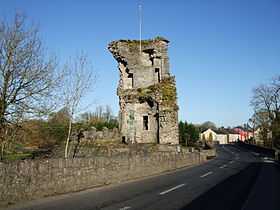Golden, County Tipperary
Golden (Irish: An Gabhailín) is a village in South Tipperary in Republic of Ireland. The village is situated on the River Suir. It is located between the towns of Cashel and Tipperary on the N74 road. In older times the village was known as Goldenbridge. It is also a parish in the Roman Catholic Archdiocese of Cashel and Emly, and is in the historical barony of Clanwilliam.
History
The bridge at Golden, which straddles an island in the River Suir, was the scene of an event of some significance in 1690, when King William III renewed, by letter in his own hand, the Royal Charter of the city of Cashel. This was an act of gratitude to the people of Cashel for the hospitality received by his followers following their attack on Limerick. The letter was preserved for posterity by the Borough of Cashel and its successors. There is a medieval castle on the island, now in a ruinous state, but which still retains a certain grandeur. Located in the castle ruins is a memorial sculptured bust of Thomas MacDonagh,(1878–1916) Tipperary-born poet and leader of the Easter Rising in 1916.
The Augustinian Athassel Priory is located south of the village. The abbey was founded by William FitzAdelm de Burgo (William de Burgh) in the last decades of the 12th century. It was once the largest abbey in Ireland and was surrounded by a small town named Athassel which was burned twice, in 1319 by Lord Maurice Fitzthomas and in 1419 by Bryan O'Brien. No fragment of the settlement survives today, though an aerial survey exposes to view, a faint tracery of old foundations close to the Abbey ruin.
Perhaps Golden's most famous son was Father Theobold Mathew, OFM (Cap), who was born at Thomastown Castle, close to Golden on 10 October 1790, though it is sometimes claimed that Rathclogheen House, close to the Castle was the place of his birth – that residence being part of the extensive family estate of the Mathew family, Earls Landaff. Father Mathew was the best known Irish temperance reformer and founded the Abstinence Society in 1838 and became widely known as the "Apostle of Temperance". To mark the centenary of the foundation of the Society, a statue in his honour was raised at Thomastown Cross in 1938 and is a very visible landmark on the N74 road, west of Golden.
One time Cashel Mayor Sir John Judkin-FitzGerald 2nd Bt of Lisheen, & High Sheriff of Tipperary [as was his father, Col Sir Thomas Judkin-FitzGerald (Uniacke) 1st Bt of Lisheen before him during the 1798 United Rebellion] lived at Golden where his 2nd wife Lady Geraldine FitzGerald d/o Preston FitzGerald of Dublin and maternal granddaughter of Major General William Pringle (of 1812 Napoleonic Wars Salamanca Battle) died of infection some days after giving birth to their only child and daughter Geraldine Caroline in 1839.
Modern Village

The village is located in the ancient parish of Relickmurry and is in the modern parish of Golden & Kilfeacle. Within the village confines, there are a number of commercial and retail enterprises, including three public houses. The Church of The Sacred Heart is a focal point in the village as is the local sportsfield, home to the local club of the Gaelic Athletic Association, Golden-Kilfeacle, which once rejoiced in the more exotic name of the Golden Fontenoys. There are two hamlets close by at Kilfeacle and Thomastown, the latter being an estate village which co-existed with the demesne of Thomastown Castle, home of the Mathew family, Earls of Llandaff.
The valley of the Suir is fertile agricultural terrain and is part of an area known as "the Golden Vale", renowned for the richness of the sub-soil which has a limestone base, eminently suitable for the raising of bloodstock. In 2002, the village had a population of 268 but it has been growing rapidly since then due to new housing development. The N74 connects Golden with Tipperary Town and Cashel, while the L3121 links it with nearby New Inn.
A recent addition [officially opened 7 July 2013] to the village is the Maher Farm Machinery Museum (also known as the Tipperary Agricultural and Heritage Museum), which holds a wide range of artifacts and exhibits covering Irish countryside life from the late 1800s up to the 1980s. It is located on the western outskirts of the village, on the N74 road near the (now operated on a part-time basis) Garda station at Persses Lot.
See also
External links
- Tipperary Agricultural and Heritage Museum image gallery - DoneDeal.ie advertisement for official opening day. Retrieved 16th July 2013.
- Tipperary Agricultural & Heritage Museum website
Coordinates: 52°30′N 7°59′W / 52.500°N 7.983°W